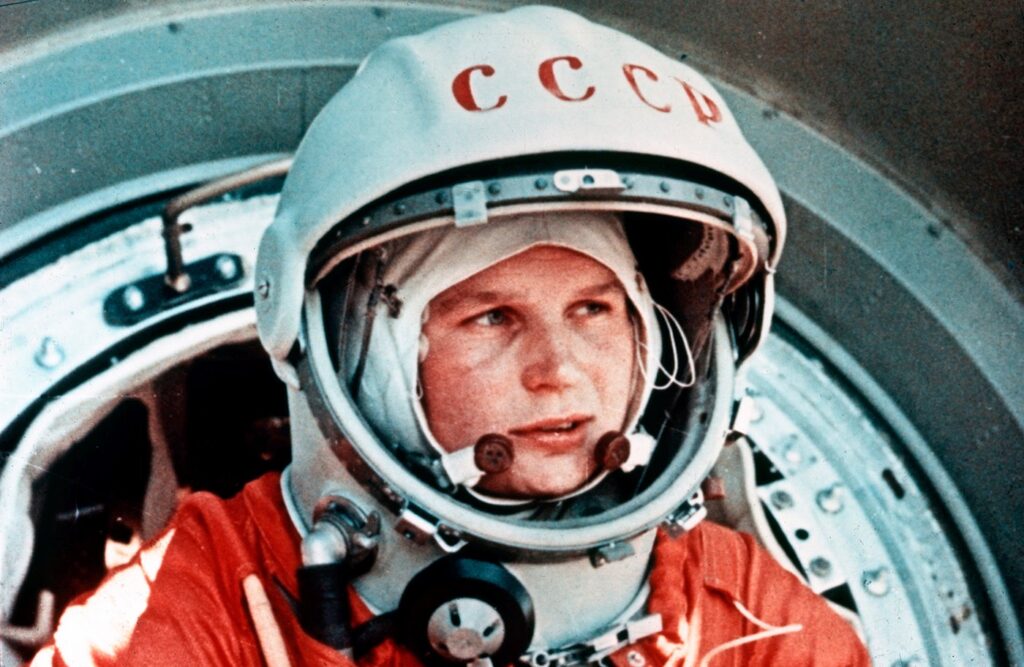Valentina Tereshkova and the birth of the Space Age
After the Second World War, the Soviet Union and the United States began what historians called a “space race.” They would confront in every arena: politics, economics, diplomacy, sports, arts, science, and particularly, rocket engineering. In fact, supremacy in the heavens became paramount for both superpowers as space was the only territory which remained to be conquered in those years. The rivalry was even terminological: in the early 1960s a distinction was observed between astronauts (the word chosen by Americans) and cosmonauts (the term preferred by Russians), and the terms “space” and “cosmos” coexisted on both sides of the Atlantic.
The first victory was for the Soviet Union and Laika, the dog who became a pioneer of the sky in 1957. Four years later, Yuri Gagarin was the first men into space, leaving American astronaut Alan Shepard behind. In 1962, John Glenn became the first American to orbit the Earth. Like military history, the “space race” seemed to be reserved exclusively for men. Fortunately, from time to time a female figure appears whose achievements outshine those of their male counterparts. That is the case of Russian cosmonaut Valentina Tereshkova (1937).
Born on March 6, 1937, in Bolshoye Maslennikovo, a village in western Russia, Tereshkova was the first female cosmonaut to travel into space. Her father, Vladimir Tereshkova, was killed fighting in the Second World War when Valentina was two years old. She began attending school at the age of ten. In 1954, she was employed as a textile worker in a local factory and continued her education through correspondence courses. But parachuting was her first love. That is why she joined the renowned paramilitary flying club in her native district and trained almost every weekend without telling her family. “I did night jumps too, on to land and water – the Volga River,” she stated. “It’s a very different experience, but both are wonderful,” she added.
Following Yuri Gagarin’s space mission in 1961, Sergei Korolyov, the father of the Soviet space programme, was determined to be the first to send a woman into space as competitiveness for space travel supremacy escalated. In February 1962, five women were selected to join the female cosmonaut corps out of more than 400 applicants. But only Valentina Tereshkova went into space. She was considered an excellent candidate as she was a highly experienced parachutist under 30 years old, less than 5.6 feet tall and less than 150 pounds in weight. Furthermore, her father was a war hero.
The group of female cosmonauts spent almost a year in intensive training including weightless flights, isolation tests, rocket theory, spacecraft engineering, parachute jumps and pilot training aboard MiG-15UTI fighters. On June 16, 1963, Vostok 6 was launched with Valentina Tereshkova aboard. The first woman in space orbited the Earth 48 times in almost three days. To see the importance of her achievement, it is worth noting that Tereshkova logged more flight hours than the combined previous cosmonauts. By way of comparison, Yuri Gagarin orbited the Earth once; and the four American astronauts who flew before her orbited a total of 36 times. She returned from her voyage by parachuting from her spacecraft to earth from 20,000 feet. Following her space mission, she was awarded the title of Hero of the Soviet Union.
Several mysteries surrounded Tereshkova’s flight. In fact, some historians and experts suggested at that time that her mission was, in many aspects, a failure. She was supposed to be very ill to handle the planned tests on board and challenge direct orders. Fifty years later, she revealed certain enlightening facts. First, Tereshkova denied being ill – or iller than might be expected. Second, she conducted and completed all the on-board tests. In fact, her voyage was extended from one to three days at her request, as the tests had been planned only for one. Finally, there was no insubordination but a grave situation. Soon after she took off, Tereshkova determined that the settings for re-entry were wrong. Had she followed such parameters, she would have been pushed into outer space rather than come back to Earth. She was sent new settings, but everybody kept it secret to save their reputation and that of the programme. “We insisted that all was OK; we didn’t talk about it. We kept it secret for 30 years until the person who made the miscalculation was in his grave”, she said.
Tereshkova celebrated her 80th birthday a few months ago. As a child of her times, she shares with other cosmonauts and astronauts a deep nostalgia for space. Longing to make another flight, she stated that she wants to go to mars, even if the mission turns out to be a one-way trip. Tereshkova’s Martian dream still requires, however, a lot of work to come true.
Max Brog
CEO
South American Jets

she’s fun